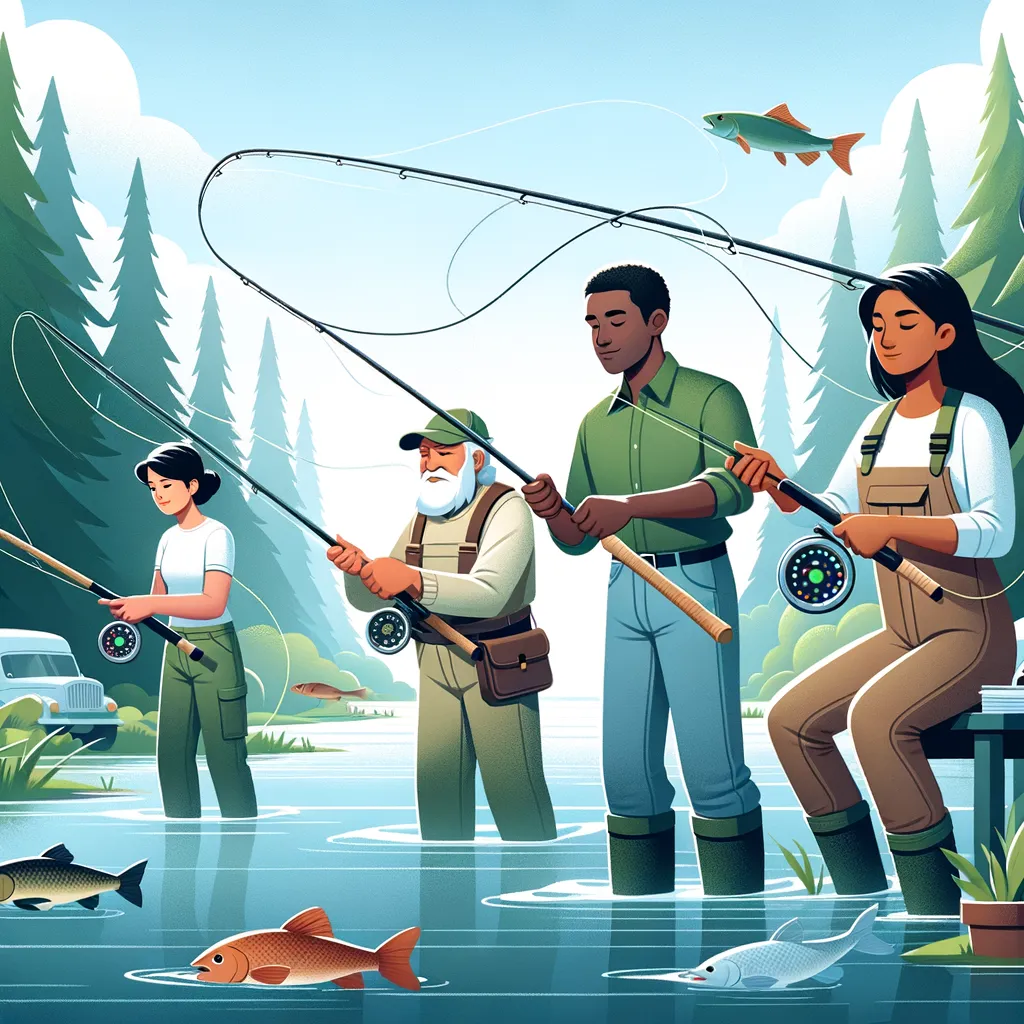Mastering the Art of Fly Fishing: A Comprehensive Guide for Parents
Welcome, adventurous parents! Are you looking to master the art of fly fishing? Whether it’s to bond with your children, immerse yourself in the beauty of nature, or simply to pick up a new hobby, fly fishing can be both a meditative and exciting experience. In this guide, we’ll walk through everything you need to know to get started, including choosing the right gear, understanding basic techniques, and finding the perfect fishing spots. Let’s dive into the sparkling world of fly fishing together!
Why Fly Fishing?
Fly fishing is not just another way to catch fish; it’s an art form that connects you more deeply with the natural world. Unlike traditional fishing, fly fishing involves hand-tying flies to mimic the look and movement of insect prey, presenting an irresistible lure to fish. It requires patience, precision, and a touch of creativity, making it a perfect activity for parents and kids to learn together. The shared moments of triumph and serene connection with nature can create lifelong memories.
Getting Equipped: The Fly Fishing Basics
Before you hit the nearest river or stream, it’s crucial to gear up properly. The fundamental pieces of equipment you’ll need include:
- Fly Rod: Your fly rod is essentially your best friend in fly fishing. It’s important to choose a rod that’s right for your level of experience and the type of fishing you plan to do. For beginners, a medium-action rod is typically the most versatile and forgiving.
- Fly Reel: The reel holds your line and helps in the retrieval of your catch. Look for a reel that balances well with your rod and is suitable for the size of fish you’re targeting.
- Fly Line: This is what you use to cast your fly out into the water. Fly lines come in various weights and types to match your rod and the kind of fishing you’re doing. Starting with a weight-forward line is a good idea for beginners.
- Leader and Tippet: These are the nearly invisible lines that connect your fly line to your fly. They help present the fly in a natural way. The leader is the thicker, longer section, while the tippet is thinner and replaces the portion of the leader that gets used up or damaged.
- Flies: The bait in fly fishing, flies, are designed to imitate insects or other prey. There’s an incredible variety of flies to choose from, each suited to different environments and fish species.
While the selection of gear might seem daunting at first, visiting a local fly shop can be a great way to get personalized advice and recommendations. Additionally, many shops offer beginner packages that include everything you need to get started.
Learning the Basics of Casting
A successful fly fisher knows that casting is the cornerstone of the sport. The unique casting techniques in fly fishing distinguish it from other types of fishing, and mastering the basic cast is your first step:
- The Overhead Cast: This is the most fundamental fly casting technique. It involves lifting the line out of the water, bringing it behind you (the backcast), and then whipping it forward over the water’s surface where you want your fly to land.
- Practicing Your Cast: Before heading out to fish, spend some time practicing your cast in an open area. Focus on developing a smooth, consistent rhythm, and remember, it’s all about the timing between your backcast and forward cast.
Practicing casting is a fun and engaging way for families to spend time together outdoors, even before hitting the water. And don’t worry about perfection; fly fishing is a journey, and every cast is a learning opportunity.
Choosing Your Fishing Spot
Finding the right spot to fish is key to a successful fly fishing outing. Research local streams, rivers, and lakes to find spots known for fly fishing. Keep in mind the type of fish you want to catch, as some species prefer specific environments. Local fly shops and online fishing communities can be excellent resources for finding the best fishing locations near you.
Remember, the goal of fly fishing is not just the catch but the experience. Look for beautiful, peaceful spots where you and your family can enjoy the beauty of nature and the thrill of the catch together.
Fly fishing is an enriching sport that offers endless opportunities for

Mastering the Art of Fly Fishing: A Comprehensive Guide for Parents
Welcome to our all-encompassing guide on mastering the art of fly fishing, specially designed for parents eager to embark on this serene and bonding journey with their children. Fly fishing is not just a sport; it’s an experience that can bring families closer, creating unforgettable memories amidst the beauty of nature. Whether you’re a seasoned angler or just starting, this guide will equip you with the knowledge to make your fly fishing adventures both enjoyable and successful.
5 Essential Tips for Parents Preparing for Fly Fishing Mastery
1. Embrace Patience and Practice: Fly fishing is an art that requires patience, practice, and persistence. Before you venture out, spend time together with your children practicing your casting in an open area. This not only hones your skills but also builds excitement for the actual fishing trips. Remember, fly fishing is about the journey and the connections you make with each other and nature.
2. Choose Equipment Wisely: Selecting the right equipment is crucial for a successful fly fishing experience. Start with a beginner-friendly, medium-action fly rod, and pair it with a balanced reel and a weight-forward fly line. Additionally, visit local fly shops for advice and to check out beginner packages, which can offer great value and ensure you have everything you need.
3. Mastering the Basics of Casting: The heart of fly fishing lies in mastering casting techniques. Focus on learning the overhead cast first, as it forms the foundation for many other casting methods. Consistent practice as a family can turn this learning phase into a fun and bonding experience. It’s okay to make mistakes – every cast is a step forward in your fly fishing journey.
4. Engage in Learning About Flies and Habitats: Understanding the different types of flies and when to use them is fundamental. Spend time together learning about the various flies and their imitations of insects and prey. Additionally, researching and understanding the preferred habitats of your target fish species will greatly increase your chances of a successful catch.
5. Respect for Nature and Conservation: Fly fishing is a wonderful way to connect with nature, but it also comes with the responsibility to protect and preserve our natural waterways. Teach your children the importance of catch and release (where appropriate), cleaning up after yourselves, and the general principles of conservation. Instilling these values early on will help ensure the longevity of this beautiful sport for future generations.
Final Thoughts
Fly fishing offers a unique blend of challenge, relaxation, and connection with the natural world. It’s a fantastic way to spend quality time together as a family, learning new skills, and creating lasting memories. By focusing on these five essential tips and embracing the journey, parents and their children can truly master the art of fly fishing. Remember, the most important aspect of fly fishing is the experience itself – the joy of being outside, learning together, and maybe even catching some fish along the way. So gear up, get out there, and enjoy the beautiful world of fly fishing together.
Embarking on the fly fishing adventure as a family not only strengthens bonds but also instills a lifelong appreciation for the environment and outdoor activities. Fly fishing is more than just catching fish; it’s about the stories you’ll tell, the laughter, the patience, and the excitement of that first successful catch. Dive into this adventure with an open heart, and let the streams and the laughter flow. Happy fishing!
Disclaimer
The articles available via our website provide general information only and we strongly urge readers to exercise caution and conduct their own thorough research and fact-checking. The information presented should not be taken as absolute truth, and, to the maximum extent permitted by law, we will not be held liable for any inaccuracies or errors in the content. It is essential for individuals to independently verify and validate the information before making any decisions or taking any actions based on the articles.



